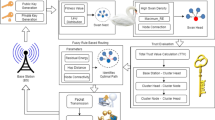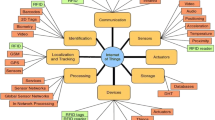Abstract
Data aggregation is a promising solution for minimizing the communication overhead by merging redundant data thereby prolonging the lifetime of energy starving Wireless Sensor Network (WSN). Deployment of heterogeneous sensors for measuring different kinds of physical parameter requires the aggregator to combine diverse data in a smooth and secure manner. Supporting multi functional data aggregation can reduce the transmission cost wherein the base station can compute multiple statistical operations in one query. In this paper, we propose a novel secure energy efficient scheme for aggregating data of diverse parameters by representing sensed data as number of occurrences of different range value using binary encoded form thereby enabling the base station to compute multiple statistical functions over the obtained aggregate of each single parameter in one query. This also facilitates aggregation at every hop with less communication overhead and allows the network size to grow dynamically which in turn meets the need of large scale WSN. To support the recovery of parameter wise elaborated view from the multi parameter aggregate a novelty is employed in additive aggregation. End to end confidentiality of the data is secured by adopting elliptic curve based homomorphic encryption scheme. In addition, signature is attached with the cipher text to preserve the data integrity and authenticity of the node both at the base station and the aggregator which filters out false data at the earliest there by saving bandwidth. The efficiency of the proposed scheme is analyzed in terms of computation and communication overhead with respect to various schemes for various network sizes. This scheme is also validated against various attacks and proved to be efficient for aggregating more number of parameters. To the best of our understanding, our proposed scheme is the first to meet all of the above stated quality measures with a good performance.








Similar content being viewed by others
References
Mitton, N. (2018). QoS in wireless sensor networks. Sensors (Basel, Switzerland), 18(11), 3983. https://doi.org/10.3390/s18113983.
Gheisari, M., Alzubi, J., Zhang, X., Kose, U., & Saucedo, J. A. M. (2019). A new algorithm for optimization of quality of service in peer to peer wireless mesh networks. Wireless Networks. https://doi.org/10.1007/s11276-019-01982-z.
Alzubi, J. A., Manikandan, R., Alzubi, O. A., Qiqieh, I., Rahim, R., Gupta, D., et al. (2020). Hashed Needham Schroeder industrial IoT based cost optimized deep secured data transmission in cloud. Measurement, 150, 107077.
Raghunathan, V., Schurgers, C., Park, S., & Srivastava, M. B. (2002). Energy-aware wireless microsensor networks. IEEE Signal Processing Magazine, 19(2), 40–50.
Karlof, C., & Wagner, D. (2003). Secure routing in wireless sensor networks: Attacks and countermeasures. Ad Hoc Networks, 1, 293–315.
Akkaya, K., Demirbas, M., & Aygun, R. S. (2008). The impact of data aggregation on the performance of wireless sensor networks. Wireless Communication and Mobile Computing, 8(2), 171–193. https://doi.org/10.1002/wcm.454.
Pu, Y., Luo, J., Hu, C., Yu, J., Zhao, R., Huang, H., et al. (2019). Two secure privacy-preserving data aggregation schemes for IoT. Wireless Communications and Mobile Computing. https://doi.org/10.1155/2019/3985232.
Ullah, I., & Youn, H. Y. (2019). A novel data aggregation scheme based on self-organized map for WSN. The Journal of Supercomputing, 75(7), 3975–3996. https://doi.org/10.1007/s11227-018-2642-9.
Sheeba Rani, S., Alzubi, J. A., Lakshmanaprabu, S. K., Gupta, D., & Manikandan, R. (2019). Optimal users based secure data transmission on the internet of healthcare things (IoHT) with lightweight block ciphers. Multimedia Tools and Applications. https://doi.org/10.1007/s11042-019-07760-5.
Ozdemir, S., & Cam, H. (2010). Integration of false data detection with data aggregation and confidential transmission in wireless sensor networks. IEEE/ACM Transactions on Networking, 18(3), 736–749. https://doi.org/10.1109/TNET.2009.2032910.
Girao, J., Westhoff, D., & Schneider, M. (2005). CDA: Concealed data aggregation for reverse multicast traffic in wireless sensor networks. In IEEE international conference on communications, 2005. ICC 2005. 2005 (Vol. 5, pp. 3044–3049). IEEE. https://www.doi.org/10.1109/ICC.2005.1494953.
Rivest, R. L., Adleman, L., & Dertouzos, M. L. (1978). On data banks and privacy homomorphisms. Foundations of Secure Computation, 4(11), 169–180.
Zhang, K., Han, Q., Cai, Z., & Yin, G. (2017). A ring-based privacypreserving aggregation scheme in wireless sensor networks. Sensors, 17, 300. https://doi.org/10.3390/s17020300.
Westhoff, D., Girao, J., & Acharya, M. (2006). Concealed data aggregation for reverse multicast traffic in sensor networks: encryption, key distribution, and routing adaptation. IEEE Transactions on Mobile Computing, 5(10), 1417–1431. https://doi.org/10.1109/tmc.2006.144.
Zhao, X., Zhu, J., Liang, X., Jiang, S., & Chen, Q. (2017). Lightweight and integrity-protecting oriented data aggregation scheme for wireless sensor networks. IET Information Security, 11(2), 82–88. https://doi.org/10.1049/iet-ifs.2015.
Vinodha, D., & Mary Anita, E. A. (2018). Secure data aggregation techniques for wireless sensor networks: A review. Archives of Computational Methods in Engineering (Springer). https://doi.org/10.1007/s1181-018-9267-2.
Barker, E., Burr, W., Jones, A., Polk, T., Rose, S., Smid, M., et al. (2009). Recommendation for key management part 1: Application-specific key management guidance. NIST Special Publication, 800, 57. https://doi.org/10.6028/NIST.SP.800-57pt1r4.
Lin, Y.-H., Chang, S.-Y., & Sun, H.-M. (2013). CDAMA: Concealed data aggregation scheme for multiple applications in wireless sensor networks. IEEE Transactions on Knowledge and Data Engineering, 25(7), 1471–1483. https://doi.org/10.1109/tkde.2012.94.
Ozdemir, S., & Xiao, Y. (2011). Integrity protecting hierarchical concealed data aggregation for wireless sensor networks. Computer Networks, 55, 1735–1746. https://doi.org/10.1016/j.comnet.2011.01.006.
Chen, C.-M., Lin, Y.-H., & Sun, H.-M. (2012). RCDA: Recoverable concealed data aggregation for data integrity in wireless sensor networks. IEEE Transaction on Parallel and Distributed Systems, 23(4), 2012. https://doi.org/10.1109/TPDS.2011.219.
Parmar, K., & Jinwala, D. C. (2016). Malleability resilient concealed data aggregation in wireless sensor networks. Wireless Personal Communications, 87, 971–993. https://doi.org/10.1007/s11277-015-2633-6.
Sri Venkateswaran, C., & Sivakumar, D. (2019). Secure cluster-based data aggregation in wireless sensor networks with aid of ECC. International Journal of Business Information Systems, 31(2), 153–169.
Boneh, D., Gentry, C., Lynn, B., & Shacham, H. (2003). Aggregate and verifiably encrypted signatures from bilinear maps. In International conference on the theory and applications of cryptographic techniques (pp. 416–432). Springer, Berlin, Heidelberg.
Agrawal, S., & Boneh, D. (2009). Homomorphic MACs: MAC-based integrity for network coding. In Proceedings of the 7th international conference on applied cryptography and network security, ACNS’09, Lecture Notes in Computer Science, 5536, 292–305. Paris-Rocquencourt: Springer. https://doi.org/10.1007/978-3-642-01957-9_18.
Qi, X., Liu, X., Yu, J., & Zhang, Q. (2019). A privacy data aggregation scheme for wireless sensor networks. In 2019 international conference on identification, information and knowledge in the internet of things (IIKI 2019).
Abukharis, S., Alzubi, J. A., Alzubi, O. A., Alamri, S., & O’Farrell, T. (2014). Packet error rate performance of IEEE802.11g under bluetooth interface. Research Journal of Applied Sciences, Engineering and Technology, 8(12), 1419–1423.
Viejo, A., Qianhong, W., & Domingo-Ferrer, J. (2012). Asymmetric homomorphisms for secure aggregation in heterogeneous scenarios. Information Fusion, 13, 285–295. https://doi.org/10.1016/j.inffus.2011.03.002.
Okamoto, T., & Uchiyama, S. (1998). A new public key cryptosystem as secure as factoring. In Advances in cryptology, proceedings of Eurocrypt’98, LNCS lecture notes in computer science (Vol. 1403, pp. 308–318). Springer.
Zhang, P., Wang, J., Guo, K., Fan, W., & Min, G. (2018). Multi-functional secure data aggregation schemes for WSNs. Ad Hoc Networks, 69(2018), 86–99. https://doi.org/10.1016/j.adhoc.2017.11.004.
Boudia, O. R. M., Senouci, S. M., & Feham, M. (2015). A novel secure aggregation scheme for wireless sensor networks using stateful public key cryptography. Ad Hoc Networks, 32, 98–113.
Bellare, M., Kohno, T., & Shoup, V. (2006). Stateful public-key cryptosystems: how to encrypt with one 160-bit exponentiation. In Proceeding of the 13th ACM conference on computer and communications security (pp. 380–389), October 2006, ACM, Alexandria, VA, 2006.
Castelluccia, C., Mykletun, E., & Tsudik, G. (2005). Efficient aggregation of encrypted data in wireless sensor networks. In Proceeding of the second annual international conference on mobile and ubiquitous systems: Networking and services (MobiQuitous), IEEE, San Diego, 2005 (pp. 109–117).
Li, X., Chen, D., Li, C., & Wang, L. (2015). Secure data aggregation with fully homomorphic encryption in large-scale wireless sensor networks. Sensors, 15(7), 15952–15973. https://doi.org/10.3390/s150715952.
Al-Rodhaan, M., Tian, Y., & Al-Dhelaan, A. (2017). A secure privacy-preserving data aggregation scheme based on bilinear Elgamal cryptosystem for remote health monitoring systems. IEEE Access, 5, 12601–12617. https://doi.org/10.1109/ACCESS.2017.2716439.
Boneh, D., Goh, E.-J., & Nissim, K. (2005). Evaluating 2-DNF formulas on ciphertexts. In Proceeding of second international conference. Theory of cryptography (TCC) (Vol. 3378, pp. 325–341).
Liu, X., Zhang, X., Yu, J., & Fu, C. (2020). Query privacy preserving for data aggregation in wireless sensor networks. Wireless Communications and Mobile Computing. https://doi.org/10.1155/2020/9754973.
Mykletun, E., Girao, J., & Westhoff, D. (2006). Public key based cryptoschemes for data concealment in wireless sensor networks. In 2006 IEEE international conference on communications, Istanbul (pp. 2288–2295).
Boneh, D., Lynn, B., & Shacham, H. (2001). Short signatures from the Weil pairing. In Proceedings of Asiacrypt 2001, 2248 of LNCS (pp. 514–532). Springer, 2001. http://crypto.stanford.edu/˜dabo/pubs.html. Accessed 19 Mar 2020.
ElGamal, T. (1985). A public key cryptosystem and a signature scheme based on discrete logarithms. IEEE Transactions on Information Theory, 31(4), 469–472. https://doi.org/10.1109/tit.1985.1057074.
Nicolosi, A., & Mazieres, D. (2004). Secure acknowledgment of multicast messages in open peer-to-peer networks. In Proceedings of the 3rd international workshop on peer-to-peer systems.
https://en.wikipedia.org/wiki/Elliptic_curve_point_multiplication.
Hankerson, D., Vanstone, S., & Menezes, A. (2004). Guide to elliptic curve cryptography. Springer Professional Computing. https://doi.org/10.1007/b9764891.
Author information
Authors and Affiliations
Corresponding author
Ethics declarations
Conflict of interest
The authors declare that they have no conflict of interest.
Additional information
Publisher's Note
Springer Nature remains neutral with regard to jurisdictional claims in published maps and institutional affiliations.
Rights and permissions
About this article
Cite this article
Vinodha, D., Mary Anita, E.A. & Mohana Geetha, D. A novel multi functional multi parameter concealed cluster based data aggregation scheme for wireless sensor networks (NMFMP-CDA). Wireless Netw 27, 1111–1128 (2021). https://doi.org/10.1007/s11276-020-02499-6
Accepted:
Published:
Issue Date:
DOI: https://doi.org/10.1007/s11276-020-02499-6




